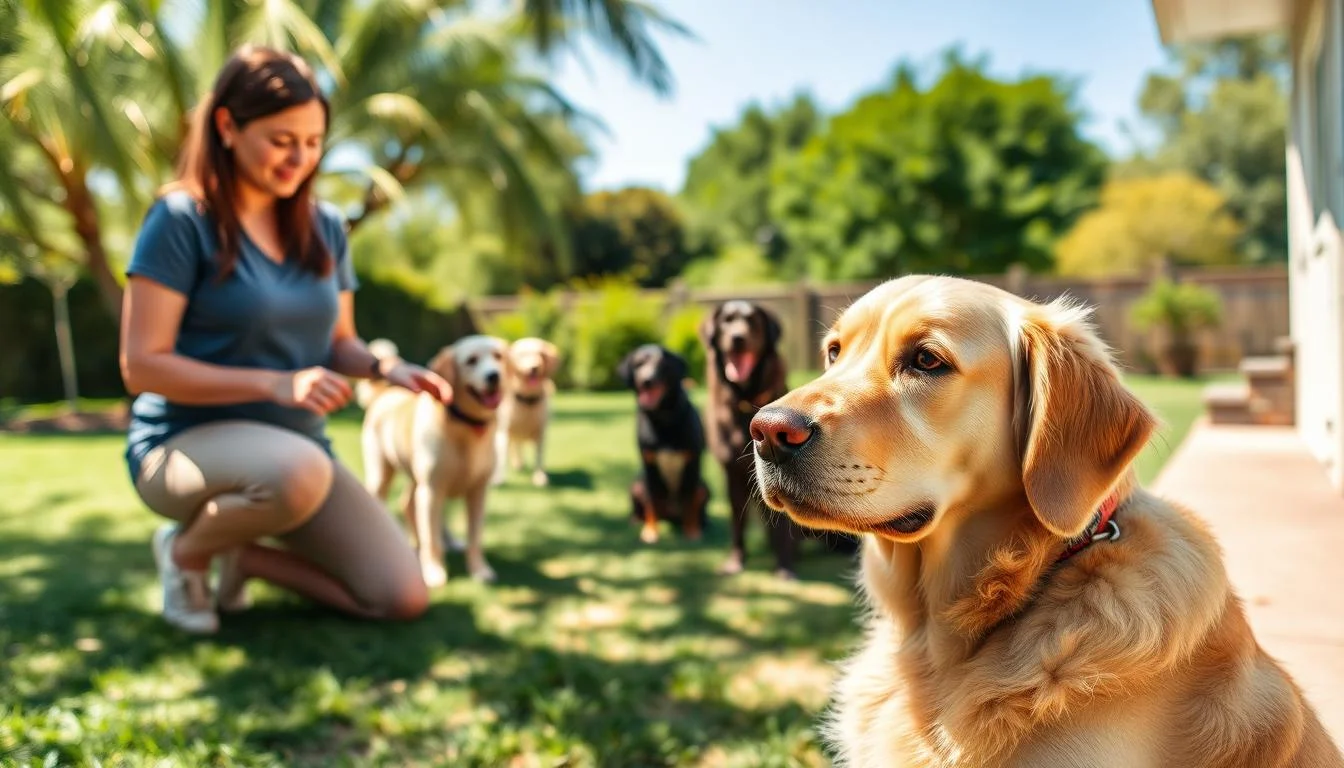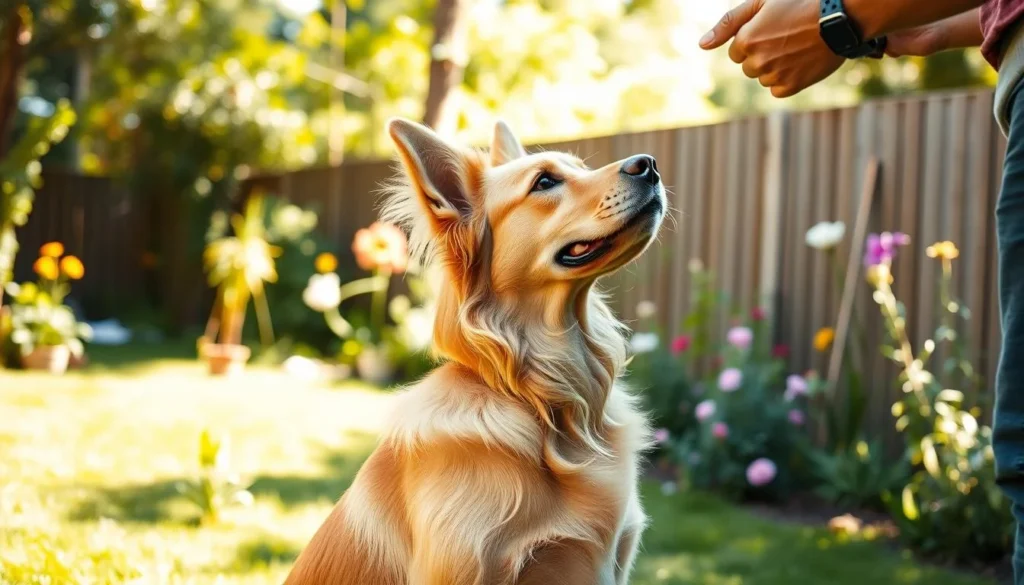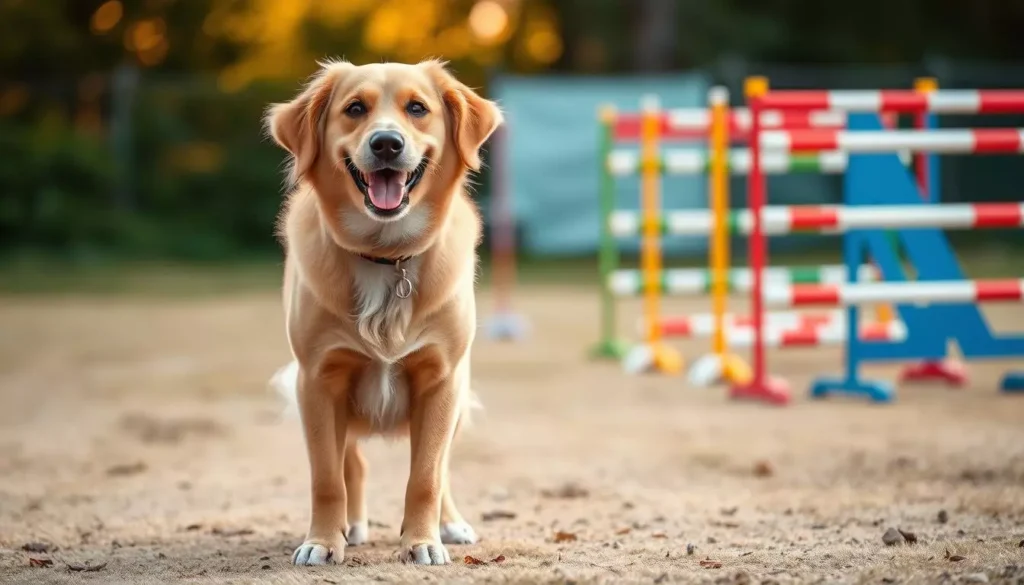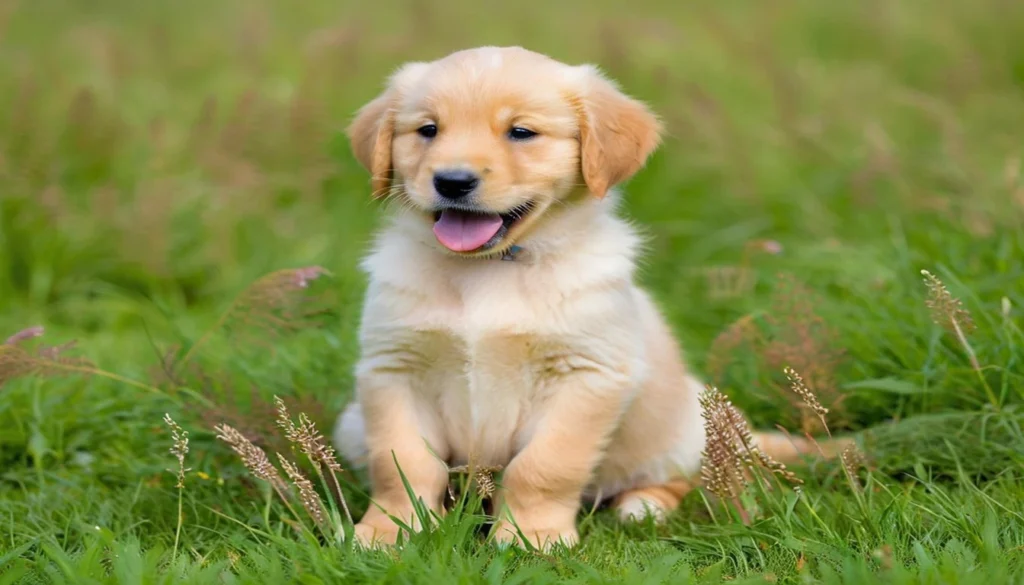I remember the first time my Labrador, Riley, shook at the doorbell. I felt lost, unsure if I should push for calm or understand his fear. Learning to be patient and respect his feelings changed everything. It's how I now handle dog anxiety training and helping dogs with anxiety.
Fear makes it hard for dogs to learn. An anxious dog can't focus on games or treats until they feel safe. To manage dog anxiety, wait for them to calm down or change the situation so they can succeed. Always be your dog's advocate by removing triggers and prioritizing their emotional needs.
I use trusted resources like newsletters and products to help Riley. Non-physical, in-home methods that look at environment and habits reduce stress. These methods help with separation anxiety, reactivity, and obsessive behaviors. Combining respect for your dog's feelings with practical tools is the start of real change.
Key Takeaways
- Recognize that fear blocks learning; prioritize calm before training.
- Modify or remove triggers rather than forcing a stressful situation.
- Use curated resources and tools to support long-term anxiety management for dogs.
- Rehabilitation-based, in-home methods focus on relationship and environment.
- Be your dog’s advocate—emotional care comes before manners.
Understanding canine anxiety and why training matters
Many owners tell me their dog seems distracted or shut down during training. Anxiety takes over their attention. A dog focused on threats will ignore cues, so progress stalls unless we tackle stress first.
I explain how anxiety affects learning. A nervous dog scans the environment instead of watching your hands. Short, scattered sessions work better than long drills when stress is high. I use calm, consistent cues so the dog can rebuild trust at a manageable pace.
How anxiety affects a dog’s learning and focus
Anxiety narrows perception. Dogs with fear lock onto triggers and miss positive signals from trainers. That makes standard reward-based lessons less reliable until arousal falls. I recommend simple, low-pressure tasks to restore focus before moving to complex commands.
Stress also reduces a dog’s motivation for treats or toys. When food fails, I switch to praise, movement games, or short impulse-control exercises to re-engage the learner without pushing past comfort.
Common triggers and early warning signs
Watching body language gives me a head start. Early signs include yawning that signals tension, lack of interest in favorite rewards, panting unrelated to heat, and displacement sniffing. I treat cowering, shaking, escape attempts, growling, or lunging as escalation points that demand immediate intervention.
Identifying triggers helps prevent full-blown reactions. Routine causes can include sudden noise, unfamiliar people, other dogs, strange surfaces, or predictable cues like picking up keys. I log context and responses to spot patterns and adjust training plans.
When to consult a professional
I urge owners to seek expert help when signs persist, intensify, or threaten safety. Severe aggression, chronic separation anxiety, or repetitive compulsive behaviors need a tailored plan. Bark Busters and certified behaviorists recommend in-home assessment because dogs often act differently in familiar spaces than they do in a training classroom.
Work with your veterinarian when medical issues might play a role. A behavior therapist can combine clinical insight with practical techniques for training anxious dogs. This collaborative approach produces assessment-driven steps, measurable goals, and clear training tips for anxious dogs you can use at home.
| Concern | Early Signs | Recommended Action |
|---|---|---|
| Attention loss during training | Ignoring cues, wandering focus | Shorten sessions, use low-pressure rewards, apply dog anxiety training basics |
| Avoidance or escape behaviors | Cowering, running away, trembling | Remove trigger, lower intensity, consult a behavior therapist for techniques for training anxious dogs |
| Threat displays | Growling, lunging, stiff posture | Prioritize safety, seek professional assessment, develop a customized plan |
| Reduced interest in rewards | No response to treats or toys | Try alternative motivators, change context, follow practical training tips for anxious dogs |
dog anxiety training strategies for building confidence
I take simple steps to help fearful dogs feel safe. Confidence helps them overcome past fears or bad social experiences. A calm routine and clear rules build trust.
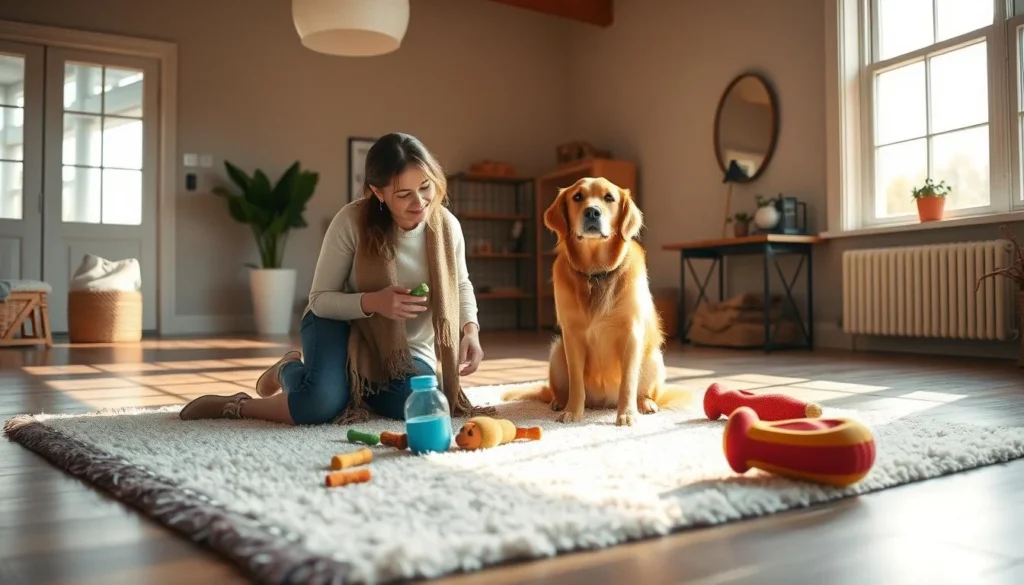
I start with a daily plan that's easy to follow. This makes dogs less stressed and helps them learn better. Feeding, walks, play, and training happen at the same times every day.
Establishing a predictable routine
I create small rituals like cues before meals and calm greetings. These moments help dogs feel in control and earn rewards. Consistent cues help them understand what's expected.
Teaching basic obedience to give control
I teach simple commands like sit, down, and stay in quiet places. I reward them for steady responses. This gives dogs choices and reliable outcomes, reducing anxiety.
Confidence-building activities and dog sports
I introduce fun challenges like agility, scent work, or rally tasks. The goal is to help them feel successful, not to compete. Success in these activities helps dogs feel more comfortable and strengthens their bond with their handler.
| Focus | What I do | Expected effect |
|---|---|---|
| Routine | Set fixed times for meals, walks, and training | Predictability that lowers baseline anxiety |
| Basic cues | Teach sit, down, recall with staged rewards | Sense of control and clearer communication |
| Gradual exposure | Introduce new tasks in calm settings | Positive experiences that expand confidence |
| Dog sports | Short, adapted agility or scent games | Build success history and resilience |
| Professional support | In-home, relationship-based guidance when needed | Custom plans that remove confusion and add clarity |
I adjust my pace to fit each dog's needs. Sessions are short to avoid stress. I focus on consistent rewards and gentle progress.
Positive rewards, clear signals, and small challenges help dogs build confidence. This approach combines daily structure with skill-building. Over time, it leads to calmer walks, easier vet visits, and a happier life at home.
Desensitization and counterconditioning techniques
I help owners take gentle steps to reduce their dog's fear. The first step is to keep the dog comfortable and below the threshold. This makes learning positive and avoids setbacks.
I start with small steps to avoid overwhelming the dog. For example, if a vacuum scares them, I start with it off and far away. If strangers worry them, I begin twenty feet away while they eat treats. This creates calm associations through counterconditioning techniques.
I watch the dog's body language closely. If they stop taking treats, tuck their tail, or freeze, I lower the intensity. This keeps sessions productive and protects trust.
Keeping your dog below threshold
Threshold management is key to safe progress. I teach owners to recognize subtle signs of stress. This way, they can adjust intensity quickly. Staying under threshold means shorter, more frequent sessions that build confidence without forcing reactions.
Stepwise progression and pairing with high-value rewards
Progress happens in small, planned steps. I raise stimulus intensity only when the dog shows calm and continues to accept rewards. I recommend treats like boiled chicken or cheese and special toys for games that reinforce positive feelings.
My approach blends desensitization for dogs with consistent rewards. This pairing turns once-scary cues into predictors of good things. Over time, the dog learns to notice the cue and expect a reward rather than panic.
Tracking progress and adjusting the plan
I record brief notes after each session: distance, trigger intensity, behaviors, and treat success. This log helps me decide when to advance or back up. Professionals at Bark Busters and other trainers stress the value of data for pacing and safety.
When progress stalls, I revisit earlier steps or introduce short breaks. I sometimes combine these techniques with natural remedies for dog anxiety such as pheromone diffusers or L-theanine after consulting a veterinarian. These supports can ease training without replacing structured desensitization and counterconditioning techniques.
Positive reinforcement methods and behavior modification
I use gentle, reward-based work to help nervous dogs. Positive reinforcement helps them make safe choices and builds trust. It reduces fear and avoids the shutdown caused by forceful methods.
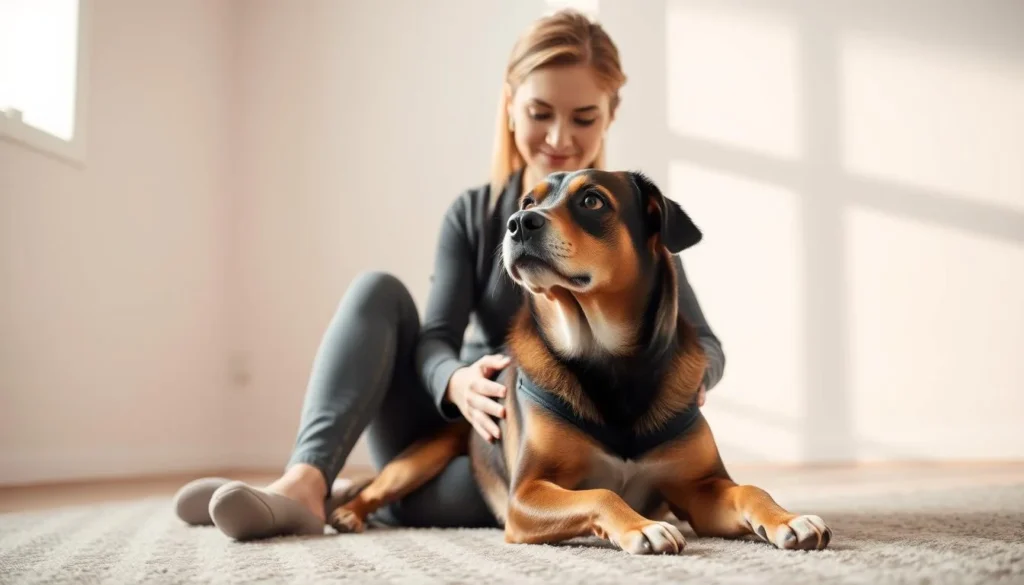
I keep learning fun with simple routines and short sessions. Small wins add up to big progress. I provide practical exercises and clear expectations for owners to follow at home.
Why positive methods work best for anxious dogs
Fear narrows a dog’s attention. Positive rewards widen it again. Rewarding calm responses creates new associations that replace anxiety, making behavior modification lasting and humane.
Punishment heightens stress and breaks trust. My approach keeps dogs below threshold and lets them choose to engage. Trainers at Karen Pryor Academy and reward-based programs report stronger, more resilient dogs with this style.
Practical exercises: nose target, approach games, and focus work
Nose target or “touch” is a first step I teach. I hold a flat hand and reward a gentle nose tap. This builds approach behavior without pressure and offers control to the dog.
Approach games let the dog set the pace near mild triggers. I mark and reward voluntary steps toward the cue, then reward stepping back. This choice reduces anxiety and supports techniques for training anxious dogs.
Focus work uses name recognition and eye contact as redirection tools. Short, frequent drills in quiet places create a reliable way to regain attention during stress.
Managing expectations and practicing patience
I tell owners to expect slow progress. Nervous dogs learn differently and need consistent repetition. I suggest private lessons if group settings feel overwhelming.
Tracking tiny gains keeps us motivated. I recommend logs of brief sessions and a plan that adjusts reward type and distance. These training tips for anxious dogs help set realistic goals and prevent rushing the process.
| Exercise | Goal | Session Structure | Example Reward |
|---|---|---|---|
| Nose target (touch) | Encourage voluntary approach | 5 minutes, multiple short trials | Small kibble or soft treat |
| Approach game | Build tolerance to mild triggers | 10 minutes, reward steps forward/back | High-value treat or play |
| Focus drills | Redirect attention under stress | 3–5 minute bursts, repeated daily | Click + treat or verbal praise |
| Choice-based interaction | Increase sense of control | Short, voluntary engagement sessions | Food, toy, or release to sniff |
Natural calming for dogs with anxiety: remedies and supports
I help owners find gentle ways to support their dogs. Natural calming methods can help dogs feel less stressed during training. I use supplements, sound tools, and simple changes in their environment.
Natural calms for dogs: supplements and herbal options
Always talk to your vet before trying new things. Look for calming supplements that your vet recommends. Brands like Zesty Paws and VetriScience have products for pets. Ask your vet how much to give your dog.
Herbal options like chamomile and valerian are in pet blends. I choose supplements made for animals, not humans. This reduces the risk of wrong dosing and upset stomachs.
Calming sounds for dogs with anxiety
Soundtracks and playlists can calm dogs. I use white-noise or music made for dogs during training. These sounds help mask loud noises and provide a calm background.
Start with short sessions and watch your dog's body language. Apps and services have playlists for dogs. Use these with treats to help your dog feel safe.
Environmental changes that soothe anxious dogs
Small changes at home can help. Create a quiet spot with familiar things. Predictable routines for walks, meals, and play also help.
Tools like pheromone diffusers and crate covers are helpful too. I find that avoiding sudden changes helps training. These strategies work best with behavioral training and vet advice.
I use these methods along with training. Natural remedies should help, not replace, training or vet advice. When used right, they make training smoother and kinder.
Training tips for anxious dogs in real-world scenarios
I guide you through simple steps to help nervous dogs in unpredictable situations. These tips cover visits, greetings, and sudden scares. They are easy to try today.
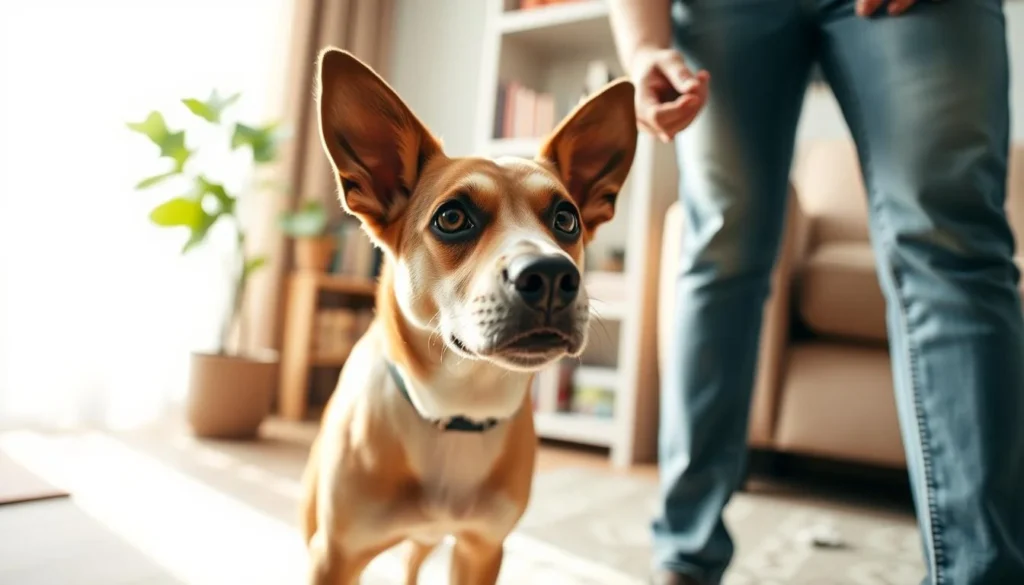
Preparing for veterinary visits and grooming
I respect the dog's feelings first. If a place feels too much, I slow down. At home, I practice handling with treats like cooked chicken.
I teach the dog to handle vet touches calmly. I start small and reward them. This makes them less scared of vet visits.
Helping dogs meet new people and other dogs
I let the dog choose how close they want to be. I use a nose target and games to help them feel in control. Visitors should move slowly and give treats.
When the dog gets better, I slowly increase the distance. I reward them often. This keeps social meetings calm.
Handling sudden triggers and on-the-spot coping techniques
I have a plan for sudden scares. I carry treats and a familiar cue. I also offer a safe place and calming sounds.
Trainers teach owners how to handle triggers. I do the same by practicing with the owner. This helps the dog stay calm in stressful situations.
Practice these tips in short, regular sessions. Keep it simple and repeatable. This builds trust and helps the dog feel safe.
Reducing anxiety in dogs during separation and home alone time
I help owners identify true signs of distress. This way, they can focus on the most effective support. It's important to know if a dog's anxiety is due to separation, boredom, medical issues, or fear.
Identifying separation anxiety versus other causes
I look for patterns like vocalizing, pacing, and destruction. These behaviors start when the owner gets ready to leave or right after they go. An in-home assessment often reveals subtle cues, like long goodbyes or ritualized departures, that make the problem worse.
Gradual departure training and desensitization to cues
I teach owners simple steps to desensitize dogs to triggers like keys and shoes. Start with short departures and reward calm behavior. Gradually increase the time alone while encouraging relaxed responses.
Enrichment and structure to ease alone-time stress
Enrichment activities change how dogs feel about being alone. Puzzle feeders, treat-dispensing toys, and scent games keep their minds busy. This reduces stress.
I suggest a predictable routine with timed walks, play, and training. A routine lowers uncertainty and helps reduce anxiety in dogs.
By combining structured enrichment and gradual departure training, owners can manage their dog's anxiety long-term. Small, consistent steps build confidence and reduce anxiety during future absences.
Calming techniques for nervous dogs during high-stress events
I help owners find ways to calm their dogs during stressful times. We focus on home, travel, and weather-related stress. Our methods include behavior training, using supportive products, and knowing when to see a vet.
Preparing for fireworks, thunderstorms, and travel
I use low-volume event sounds and treats to help dogs get used to them. We start early, so dogs learn to stay calm. We practice in short, gentle steps, keeping the dog comfortable.
For travel, we crate train and practice short drives. We also use consistent routines and special dog playlists. These steps make trips smoother and help dogs adjust better.
Use of pressure wraps and other non-invasive supports
I recommend aids like pressure wraps, pheromone diffusers, and chew toys. A Thundershirt can help by providing constant, gentle pressure. We introduce these items slowly, so dogs feel safe and comfortable.
We also use pheromone products, white-noise machines, and controlled lighting. These create a calm environment. We pair these with treats to help dogs associate them with relaxation.
When medication is a temporary tool
I work with vets and trainers to know when medication is needed. It can help reduce extreme anxiety, making training easier. We always use medication with a behavior plan and follow vet advice.
Deciding when to use medication depends on safety and learning. If a dog is too scared to train, medication can help. We monitor progress and adjust medication as needed.
| Situation | Behavioral Step | Non-Invasive Support | When to Consider Medication |
|---|---|---|---|
| Fireworks night | Desensitization using low-volume recordings and reward pairing | Pressure wraps for dogs, calming playlists, closed curtains | If panic risks injury or prevents training, consult your vet |
| Thunderstorms | Short practice sessions with recorded thunder and positive reinforcement | Pheromone diffusers, snug bedding, pressure wraps for dogs | If trembling and escape attempts persist despite supports |
| Travel by car or plane | Gradual travel conditioning, crate training, short practice trips | Travel-safe calming aids, non-slip bedding, calming sounds for dogs | When nausea, severe trembling, or aggression occur during travel |
Measuring success and adapting your anxiety management for dogs
I track progress like a pro, using simple metrics and notes. Small wins add up. I look for signs like fewer yawns, calmer panting, and more interest in treats.
Setting measurable, realistic goals
I set goals that are clear and achievable. For example, a dog might take a treat in 10 seconds when someone walks by. Or they might stay calm in a car for five minutes. I record the starting point before we begin.
Monitoring behavior changes over time
I keep a log of each session. It includes the date, how long we were near the trigger, and how the dog reacted. I track how many times they approach a trigger and how long they stay calm.
Adjusting techniques based on individual dog differences
Every dog learns differently. If progress slows, I change the pace, rewards, or setting. Sometimes, we need help from a certified trainer or vet. If things get worse, I slow down and go back to basics.
I talk to experts when we hit a wall or new issues arise. Using clear goals and flexible plans helps us make progress without being too hard on the dog.
Conclusion
I think the key to good dog anxiety training is simple. It's about respecting your dog's feelings, using positive methods, and building trust and routine slowly. When I mix desensitization and counterconditioning with a daily routine, dogs become calmer and more focused.
To help dogs with anxiety, I suggest using trusted resources and products. I also use natural calming methods like supplements, soothing sounds, and changes in their environment. This helps reduce stress without needing medication.
If a dog's behavior problems are serious or if safety is a worry, I advise getting professional help. Look for in-home, non-physical therapy that works with vets. It should offer a personalized plan for the long term. With patience and the right support, dogs can really improve.

